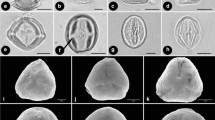Abstract
External pollen grain morphology has been widely used in the taxonomy and systematics of flowering plants, especially the Acanthaceae which are noted for pollen diversity. However internal pollen wall features have received far less attention due to the difficulty of examining the wall structure. Advancing technology in the field of microscopy has made it possible, with the use of a focused ion beam–scanning electron microscope (FIB–SEM), to view the structure of pollen grain walls in far greater detail and in three dimensions. In this study the wall structures of 13 species from the Acanthaceae were investigated for features of potential systematic relevance. FIB–SEM was applied to obtain precise cross sections of pollen grains at selected positions for examining the wall ultrastructure. Exploratory studies of the exine have thus far identified five basic structural types. The investigations also show that similar external pollen wall features may have a distinctly different internal structure. FIB–SEM studies have revealed diverse internal pollen wall features which may now be investigated for their systematic and functional significance.















Similar content being viewed by others
References
Anjum P, Qaiser M (2010) Pollen flora of Pakistan—LXVII: Acanthaceae. Pak J Bot 42:175–191
Balkwill K, Getliffe Norris F (1988) Classification of the Acanthaceae: a southern African perspective. Monogr Syst Bot Mo Bot Gard 25:503–516
Barnes SH (1992) Ultrastructural imaging of freeze fractured plant cells in the scanning electron microscope. Microsc Res Tech 22:160–169
Blackmore S, Barnes SH (1986) Freeze fracture and cytoplasmic maceration of pollen grains. Grana 25:41–45
Bremekamp CEB (1953) The delimitation of the Acanthaceae. Proc Kon Ned Akad Wetensch: Ser. C 56:533–546
Bremekamp CEB (1965) Delimitation and subdivision of the Acanthaceae. Bull Bot Surv India 7:21–30
Daniel TF (1986) New and reconsidered Mexican Acanthaceae. II. Southwest Nat 31:169–175
Daniel TF (1990) New and reconsidered Mexican Acanthaceae. IV. Proc Calif Acad Sci 46:279–287
Daniel TF (1998) Pollen morphology of Mexican Acanthaceae: diversity and systematic significance. Proc Calif Acad Sci 50:217–256
Doyle JA (2009) Evolutionary significance of granular exine structure in the light of phylogenetic analyses. Rev Palaeobot Palynol 156:198–210
Doyle JA, Le Thomas A (2012) Evolution and phylogenetic significance of pollen in Annonaceae. Bot J Linn Soc 169:190–221
Fritzsche J (1832) Beiträge zur Kenntnis des Pollen 1. Stettin und Elbing, Berlin
Furness CA (1990) Pollen morphology of Crossandra Salisbury and Crossandrella C.B. Clarke (Acanthaceae: Acantheae). Grana 29:161–176
Furness CA (1991) Pollen morphology of Sclerochiton (Acanthaceae: Acantheae). Kew Bull 46:51–59
Furness CA (1993) A pollen morphological survey of the old world species of Stenandrium Nees (Acanthaceae: Acantheae). Grana 32:1–11
Furness CA (1994) The pollen morphology of Hygrophila and Brillantaisia (Acanthaceae: Ruellieae). Acta Bot Gallica 141:267–278
Furness CA (1995) A pollen morphological study of Dyschoriste Nees and Chaetacanthus Nees (Acanthaceae: Ruellieae). Rev Palaeobot Palynol 84:331–345
Furness CA (1996) Pollen morphology of Acanthopsis Harvey, Acanthus L. and Blepharis Jussieu (Acanthaceae: Acantheae). Rev Palaeobot Palynol 92:253–268
Furness CA (1997) Abnormal pollen in Blepharis and other genera in Acanthaceae. Proc 4th EPPC 58:273–283
Graham VAW (1988) Delimitation and infra-generic classification of Justicia (Acanthaceae). Kew Bull 43:551–624
House A, Balkwill K (2013) FIB–SEM: an additional technique for investigating internal structure of pollen walls. Microsc Microanal 19:1535–1541
Immelman KL (1989) Studies in the southern African species of Justicia and Siphonoglossa (Acanthaceae): palynology. Bothalia 19:151–156
Lindau G (1895) Acanthaceae. In: Engler A, Prantl K (eds) Die natuerlichen Pflanzenfamilien. (3b). Wilhelm Engelmann, Leipzig pp 274–354
Moore PD, Webb JA, Collinson ME (1991) Pollen analysis, 2nd edn. Blackwell Science Ltd, Oxford, pp 76–77
Muller J, Schuller M, Straka H, Friedrich B (1989) Palynologia Madagassica et Mascarenica. Fam. 182: Acanthaceae. Trop Subtrop Pflanzenwelt 67:138–187
Radlkofer L (1883) Ueber den systematischen werth der pollenbeschaffenheit bei den Acanthaceen. Sitzungsber Math-Phys Cl der Königl Bayer Akad Wiss München 13:256–314
Raj B (1961) Pollen morphological studies in the Acanthaceae. Grana Palynol 3:3–108
Scotland RW (1990) Homology, pollen grains and microscopy. Proc Roy Microscop Soc 25:108
Scotland RW (1992a) Systematics, similarity and Acanthaceae pollen morphology. Bot J Linn Soc 109:529–541
Scotland RW (1992b) Pollen morphology of Andrographideae (Acanthaceae). Rev Palaeobot Palynol 72:229–243
Scotland RW (1993) Pollen morphology of Contortae (Acanthaceae). Bot J Linn Soc 111:471–504
Scotland RW, Vollesen K (2000) Classification of Acanthaceae. Kew Bull 55:513–589
Tripp EA, Daniel TF, Fatimah S, McDade LA (2013) Phylogenetic relationships within Ruellieae (Acanthaceae) and a revised classification. Int J Plant Sciences 174:97–137
Walker JW (1974) Evolution of exine structure in the pollen of primitive angiosperms. Am J Bot 61:891–902
Walker JW, Doyle JA (1975) The bases of angiosperm phylogeny: Palynology. Ann MO Bot Gard 62:664–723
Walker JW, Skvarla JJ (1975) Primitively columellaless pollen: a new concept in the evolutionary morphology of Angiosperms. Science 187:445–447
Acknowledgments
We are deeply grateful to Dr Thomas Malwela from the National Centre for Nanostructured Materials at the CSIR for his time and expertise conducting the FIB work and to Willem Froneman at the Lowveld Botanical Gardens for help with collection of sample species. This work was supported by the National Research Foundation [Grant Number 65704].
Author information
Authors and Affiliations
Corresponding author
Rights and permissions
About this article
Cite this article
House, A., Balkwill, K. Labyrinths, columns and cavities: new internal features of pollen grain walls in the Acanthaceae detected by FIB–SEM. J Plant Res 129, 225–240 (2016). https://doi.org/10.1007/s10265-015-0777-9
Received:
Accepted:
Published:
Issue Date:
DOI: https://doi.org/10.1007/s10265-015-0777-9




